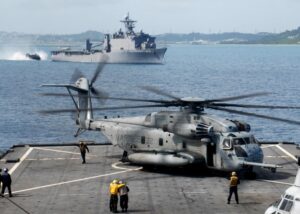A Ticonderoga-class cruiser is almost finished with hundreds of millions of dollars of modernization work, but the Navy is still seeking to decommission it next year.
During a House Armed Services seapower and projection forces subcommittee on Wednesday, Ranking Member Rob Wittman (R-Va.) asked Navy officials how far along the USS
Vicksburg (CG-69) and Whidbey Island-class dock landing ship USS Tortuga (LSD-46) are in their modernization maintenance availabilities. Navy officials were testifying on the Navy’s fiscal year 2023 budget request.
Jay Stefany, principal civilian deputy to the Assistant Secretary of the Navy for Research, Development and Acquisition, confirmed both ships are in their cruiser and LSD mod programs, respectively, an availability that aims to extend their service lives.
“The cruiser Vicksburg, I think, is in that 85 percent range. Tortuga, the LSD, might be a little less but it’s mostly complete, to your point,” Stefany said.
Wittman also asked how much money had already been spent on the work as well.
“How much has been spent on those availabilities–the cruiser and the LSD are a little different, but in the $200-$300 million range–” but closer to $300 million.
CG-69 and LSD-46 are two of the 24 ships the Navy is requesting to retire in FY ‘23 in an effort to redirect funds to other efforts. If approved, the Vicksburg would retire four years earlier than the planned 35-year service life and Tortuga would retire seven years earlier than its 40-year expected service life (Defense Daily April 25).
The Navy said it expects to save $3.6 billion over the next five years by retiring the 24 ships in FY ‘23 (Defense Daily, March 28).

Both ships are undergoing their modernization programs at the BAE Systems ship repair facility in Norfolk, Va. Wittman’s district covers some of the area around the Norfolk shipyards and naval facilities.
Relatedly, on May 18 the Navy awarded BAE another $8 million modification to incorporate a request for a contract change for a 217-day extension to accomplish “growth work” on Vicksburg modernization.
The work is expected to be finished by March 2023. The contract announcement said if this mod is awarded the total contract value will increase up to $214.6 million.
Separately, during a House Appropriations Committee defense subcommittee (HAC-D) hearing also held on Wednesday, Rep. Kay Granger (R-Texas) also expressed her strong disapproval of the Navy’s plan to decommission 24 ships while building eight new ones, naming the Vicksburg as a prime example of mismanaging funds.
“Some of these ships, especially Littoral Combat Ships, are among the newest in the fleet. The Navy claims they don’t have enough sufficient funding to maintain and operate these ships, but that’s not the case. Instead, they’ve mismanaged billions of dollars in maintenance funding. One glaring example of this is the USS Vicksburg, a cruiser up for decommissioning this year,” she said.
“Since 2020, the Navy has awarded nearly $500 million in contracts to upgrade the cruiser. At a time when the ship is still in its maintenance period, the Navy is proposing to scrap it. If the Navy experts expect Congress to support its vision for this fleet, it must do a much better job of managing the inventory it has. We will not stand idly by as valuable taxpayer funds are wasted,” Granger continued.
During the HAC-D hearing, Chief of Naval Operations Adm. Mike Gilday repeated his defense that the LCSs are less lethal and capable for the current threat. The Navy budget plans to decommission nine Freedom-variant LCSs, most of which were set to include the now-canceled anti-submarine warfare (ASW) modules. The modules failed to perform adequately in testing and Gilday says he refused to add any more funds to the failed system. The Navy plans to instead use the upcoming Constellation-class frigates for the ASW mission.
“With respect to the decommissioning – we took a look at our top line and we took a look at a Navy that we can sustain, a Navy that we can afford. But to make it the most lethal, capable ready Navy that we can. In other words, we’re trying to field the most lethal capable ready Navy we can based on the budget that we have, rather than a larger Navy that’s less capable, less lethal and less ready.”
Gilday added that the Navy stratified its warfighting platforms and the LCSs and older cruises fell to the bottom.
He noted several of the older cruisers have leaks below the waterline as well as radars that cannot detect the newest Chinese threats.
“Regrettably, we made tough decisions in this budget proposal to decommission and propose to decommission ships that just wouldn’t have added value to the fight. At the same time we’re taking that money and investing it in our priorities, which are readiness, modernization, and then capacity at an affordable rate,” Gilday said.
The CNO has said the Navy’s FY’23 budget is, among other things, trying to maximize domestic production of longer range and high-speed weapons like the Lockheed Martin [LMT] Long Range Anti-Ship Missile (LRASM), Joint Air-to-Surface Standoff Missile -Extended Range (JASSM-ER), and Raytheon Technologies [RTX] Maritime Strike Tomahawk missile.
“So we’re trying to invest in readiness, first and foremost, and also modernizing a fleet–70 percent of which we’re going to have in the early 2030s,” Gilday said.